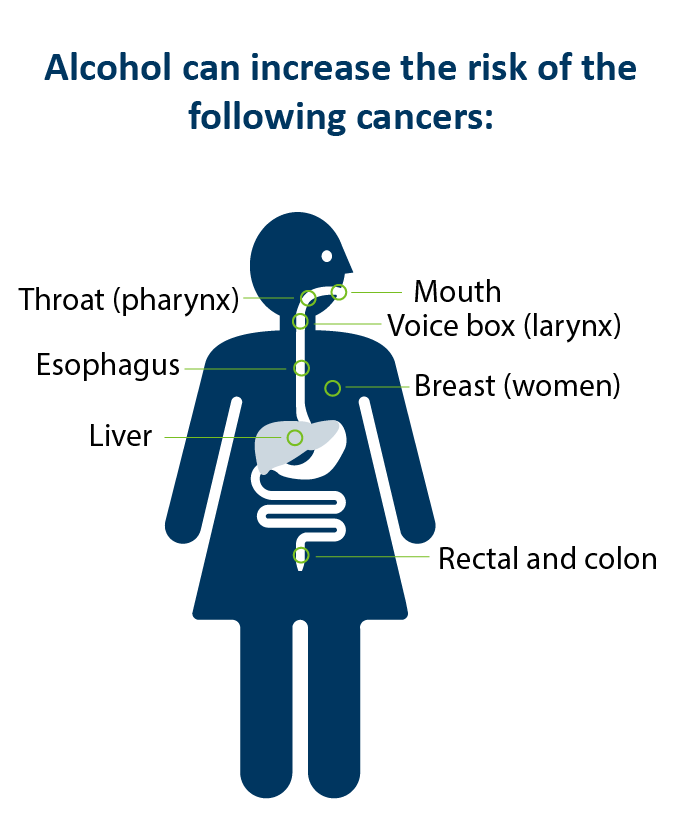Alcohol and Other Drugs
Alcohol Basics
Alcohol Data
Related Topics
Alcohol and Cancer

Many people are aware that alcohol is linked to health problems. But many might not know that drinking alcohol can raise the risk of getting certain forms of cancer. This is true for all alcohol beverages including beer, wine, and distilled spirits. Research has shown that drinking alcohol can increase the risk of the following cancers:
- mouth
- throat (pharynx)
- voice box (larynx)
- esophagus
- breast (in women)
- stomach
- liver
- rectal and colon
For each of these cancers, the more alcohol you drink, regardless of beverage type, the higher the risk of cancer. See Alcoholic drinks and the risk of cancer - World Cancer Research Fund and American Institute for Cancer Research (PDF)
Alcohol and cancer are connected
Alcohol is a group 1 carcinogen like tobacco.
In the body, alcohol turns into acetaldehyde, which is a known carcinogen, or cancer-causing agent. When this toxic chemical builds up in the body, it damages DNA and prevents the body from repairing itself. Cells can begin to grow out of control, which can lead to tumors.
Other ways alcohol can contribute to cancer:
- Contaminants can be introduced to alcoholic beverages while it is being made.
- Regular, heavy alcohol use can damage the liver, leading to inflammation and scarring. This might raise the risk of liver cancer.
- Even one glass of alcohol raises levels of estrogen, which can add to breast cancer risk.
- Alcohol can make it easier for the body to absorb other cancer-causing chemicals in tobacco if used together.
- Alcohol can change how other nutrients are absorbed and broken down in the body.
In 2022, cancer was the leading cause of death in Minnesota, and an estimated 3.2% of those deaths were related to alcohol.
Alcohol use in Minnesota
Most adults in Minnesota drink alcohol. In 2023, 61.4% of men and 55.5% of women in Minnesota reported drinking alcohol. Minnesota has one of the highest binge drinking rates in the nation with 17.0% of adults reporting binge drinking in 2023, compared to 15.1% of all U.S. adults. More information on Alcohol Use in Minnesota.
Reducing risk of cancer
Any amount of alcohol consumption can increase the risk of cancer. Reducing drinking from heavy to moderate or low levels is associated with decreased risk for alcohol-related cancers and unnecessary deaths.
There are effective policy strategies that aim to reduce access to alcohol for youth and support lower alcohol consumption overall. For example, increasing the cost of alcohol, regulating the density and location of alcohol establishments, and screening and brief intervention may help Minnesota communities reduce alcohol use. The Community Guide Excessive Alcohol Consumption shares policy ideas and implementation resources.
Additional resources
For more information
Kari Gloppen at kari.gloppen@state.mn.us or Kathleen Dubberley at Kathleen.Dubberley@state.mn.us for alcohol-related data, policy, or program information.